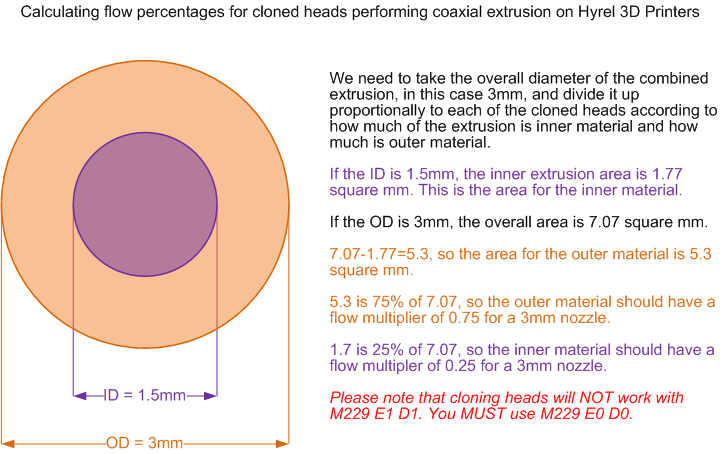Cloning and Mixing
Cloning heads is when two heads will both execute the exact same gcode at the exact same time.
Mixing heads like the SMH-2 and DMH-2 each take the output from two other heads and blend them through static (SMH) or dynamic (DMH) blending baffles or blades, with final deposition of a (hopefully) homogeneous blend.
Whether you're mixing your output or not, step one is to clone the heads.
Cloning
NOTE: M703 (cloning) DOES NOT WORK WITH M229 E1 D1. YOU MUST USE M229 E0 D0 (native flow calculations instead of E values).
NOTE: M703 (cloning) DOES NOT WORK WITH M723 (manual flow). Cloning only works for G1/G2/G3 printing moves.
Clone, slave, or parallel printing, is when one head makes a normal print, and another head makes the exact same print at the same time.
We will normally execute a T command first, to establish the primary or master head (generally the one to the left). Then the M703 command, cloning or slaving another head to the first.
Remember, this is how we address the tool positions; note that the 30M and ESR have four positions, not five. Counting from the leftmost position:
| Command | 1st Slot | 2nd Slot | 3rd Slot | 4th Slot | 5th Slot |
|---|---|---|---|---|---|
| Tool Change | T0 | T1 | T2 | T3 | T4 |
| Clone Address | T11 | T12 | T13 | T14 | T15 |
| Master Address | S11 | S12 | S13 | S14 | S15 |
In the following example we have a five-position yoke; commands executed by the head in slot 1 (far left) will also be executed by the heads in both slot 3 (third from left) and slot 5 (fifth from left):
T0 M703 T13 S11 M703 T15 S11 G4 P1
These commands are decoded and executed by the printer as follows:
- T0 - Assign commands to Position 1 (the far left head on yoke 1)
- M703 - Begin to Duplicate Commands:
- T13 - Tool Position 3
- S11 - Slave to Position 1
- M703 - Begin to Duplicate Commands:
- T15 - Tool Position 5
- S11 - Slave to Position 1
- G4 (timed pause)
- P1 (one millisecond)
Note that only Hydra (16A) and High Resolution Engine (EHR) units have five tool positions; other models have four only. See Understanding the T at the top of the Gcode page for tool position nomenclature.
End Cloning/Parallel Printing
The M704 command will remove a head from the clone list of another head.
In the following example we have a five-position yoke; we will order the head in slot 5 (fifth from left) to no longer duplicate commands sent to slot 1 (far left):
M704 T15 S11
This command is decoded and executed by the printer as follows:
- M704 - End Duplication:
- T15 - Tool Position 5
- S11 - No longer Slaved to Position 1
Mixing
Now that you have the cloning set up, it's time to do the mixing. Connect the pneumatic tubing to direct the flow from the two supply heads to the mixing head.
SMH
The Static Mixing Head is easy - connect and you're done.
DMH
The Dynamic Mixing Head requires air pressure (to spin the blades) and an electrical connection (wires provided) to the primary head, to activate the flow valves for printing and non-printing moves. It also takes a command to control blade spinning speed.
Remember, this is how we address the tool positions; note that the 30M and ESR have four positions, not five. Counting from the leftmost position:
| Command | 1st Slot | 2nd Slot | 3rd Slot | 4th Slot | 5th Slot |
|---|---|---|---|---|---|
| Variable | T11 | T12 | T13 | T14 | T15 |
In the following example we will dispense 25% of the material from slot 2 and 75% of the material from slot 4:
M221 S0.25 T12 M221 S0.75 T14 G4 P1
These commands are decoded and executed by the printer as follows:
- M221 - Update flow calculations
- S0.25 - Material Feed Rate Multiplier 0.25
- T12 - On yoke 1, slot 2
- M221 - Update flow calculations
- S0.75 - Material Feed Rate Multiplier 0.75
- T14 - On yoke 1, slot 4
- G4 (timed pause)
- P1 (one millisecond)
At any point, we can change the ratios - in this example, we'll change the ratios to 80% slot 2, 20% slot 1:
M221 S0.80 T12 M221 S0.20 T14 G4 P1
These commands are decoded and executed by the printer as follows:
- M221 - Update flow calculations
- S0.80 - Material Feed Rate Multiplier 0.80
- T12 - On yoke 1, slot 2
- M221 - Update flow calculations
- S0.20 - Material Feed Rate Multiplier 0.20
- T14 - On yoke 1, slot 4
- G4 (timed pause)
- P1 (one millisecond)
It can be helpful to also clone the mixer to the primary supply head, and set the flow rate so that the blending mechanism stirs at your desired speed with an M221 S# command.
Coaxial Extrusion
Coaxial extrusion is just like the mixing examples above in that the flow rates for both materials must add up to 1.0 for the specified nozzle diameter.
Coaxial extrusion is different in that instead of blending the materials, we will flow one inside of the deposition path for the other. This image should help:
Just like with the examples above, you can set these percentages in your gcode or you can set them on the extruders.
Remember, extruder values are sent to the printer first, and then the gcode, and if any values are different, the most recent one overwrites the original one.

